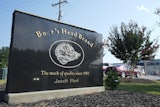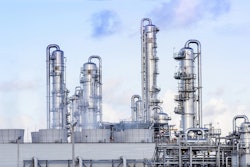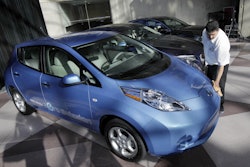(Editor's note: This article originally appeared in the March/April 2016 print issue of Food Manufacturing)
America is getting serious about food supply safety. With the Food Safety Modernization Act taking effect, food safety guidelines that once were merely best practices are becoming law. While this new regulation is having a ripple effect across the spectrum of food manufacturing products, it is particularly pronounced in door technology.
Wash-Down Doors
Wash-down doors are a primary example. A new generation of flexible, fabric doors has been developed in recent years that feature anti-microbial materials and other upgrades for wash down applications. Unlike traditional hard core doors, these new doors roll upwards (rather than sliding sideways) and have extremely fast cycle times, with some moving as rapidly as 100 inches per second. Developed to meet USDA, FDA and GMP standards, they are made of smooth polypropylene, a material that provides higher resistance to acids and bases and a lower water absorption rate than vinyls and urethanes. This material upgrade is a key component of their appeal, as it makes them highly resistant to mold and extremely durable against the stresses of daily wash-downs using chemical solvents.
Additionally, the new generation of wash down doors have tapered surfaces and stand-offs that all but eliminate “harborage” of bacteria or other contaminants. They are also designed to be highly corrosion-resistant. This includes the use of stainless steel and UHMW components, and the elimination of shrouds hinges and reversing edges as they add to cleaning time and could harbor contaminants.
Freezer/Cooler Doors
Door technology has also been rapidly advancing with regard to freezer and cooler areas of food manufacturing facilities. In the past, these applications typically involved heavy, hard-core doors with high R-values that minimized conduction (energy loss through the door panel). Unfortunately, these doors were relatively slow-moving. In today’s increasingly fast-paced environment, freezers and coolers are accessed more frequently than ever before, so the conduction-fighting benefits of these doors are outweighed by their slow cycle times – which allow an undue amount of heat to enter the freezer through convection. The slow cycle times also made it harder to maintain temperature control inside the cooler or freezer – potentially jeopardizing product integrity – and hampered productivity, as workers had to constantly wait on the doors to open or close.
In recent years, manufacturers began to realize that lighter, faster-acting roll-up doors might be a better option, since they minimize energy loss due to open/close time. However, the initial generations of these doors had their own drawbacks. Poor sealing characteristics were a problem in some, and many had R-values too low to prevent frost from building on the surface of the door panel. This led many facilities to add expensive defrost systems like heat lamps or air curtains to alleviate the problem.
Strip curtains and air systems were also widely used, with mixed results. While strip curtains are comparatively inexpensive, they are not particularly good at sealing most freezer applications. Additionally, their R-value is very low, making frost build-up a potential problem. This can lead to hazardous working conditions as scratches in the plastic and frost on the strips can obscure a forklift driver's vision, and the poor seal allows for frost and ice to build up on the floor.
Air systems can be either stand-alone or housed in multiple units integrated into a vestibule assembly. Often these systems are very expensive and don't seal the opening well. In fact, most of these systems are now sold in conjunction with a high speed door. Vestibules can also require a large footprint, eating up valuable floor space. Air units generally consist of heaters that reduce the relative humidity of the infiltrating air. Unfortunately, it usually takes a tremendous amount of energy for them to operate at a level that keeps the opening ice- and frost-free.
High-Speed, High-Tech Freezer Doors
Recognizing the need for improvements, many food manufacturing facilities have switched to newer, more high-tech doors in their freezer and cooler areas. Recent improvements in door technology combine fast cycling with high-efficiency insulation and sealing. These innovations contribute to low long-term energy costs, improved efficiency and increased food and employee safety. In short, high R-value is no longer the main driver in door selection.
In fact, the International Energy Conservation Code (IECC) is beginning to recognize the importance of high-speed doors. Its 2015 edition includes a revision to Table C402.4.3 (pages 242-244), which describes the maximum air infiltration rates for fenestration assemblies. At 1.3 CFM/FT2, high-speed doors have the largest rate of infiltration in the table. As the table notes, however, this is because the “high speed nature of these doors provides for minimizing of ‘air exchange,’ a valuable and predominant characteristic of minimizing overall energy losses through a door opening.”
The fastest roll-up doors can operate at 100 inches per second, a rate which minimizes air infiltration and ensures optimal productivity. Newer upward-acting doors are constructed with a high enough R-value to avoid needing expensive panel defrost systems. Some also incorporate a perimeter thermal air seal for added energy efficiency. In addition to their temperature separation capabilities, the most advanced high-speed doors comply with GMP guidelines that are frequently referred to by the FDA and USDA.
“Impactability” is another hallmark of these technologically advanced doors. Unlike traditional rigid doors, they have the ability to withstand forklift impact, which minimizes maintenance and downtime and helps maintain a tight seal over the life of the door. Some doors even reset themselves automatically when they are impacted. This ensures that the door is back to the closed position, sealing the opening, even if a person forgets to reset the door.
In-Plant Safety Trend Coming
While technological advances like reversing capabilities, vision panels and higher cycle times have made industrial doors safer than ever, the areas around them can still be dangerous. Not knowing what’s immediately on the other side of a door – and potentially headed at you – can be hazardous. Yet, unlike loading docks, the areas surrounding high-speed doors inside a facility are typically devoid of any light communication devices.
That is starting to change. Light communication systems can provide forklift operators and pedestrians a clear sign about whether a door entry is safe or not. Using universally understood red and green lights, light systems can alert nearby workers if something will be coming through the threshold. Expect to see more light communication options for in-plant door areas in 2016.
Choosing the Right Door
Regardless of a door’s configuration, its cycle time, energy efficiency, anti-microbial properties and wash-down features should be key considerations when evaluating options. In addition to considering these attributes, smart facility managers will also refer to Hazard Analysis & Critical Control Points (HACCP) best practices, which are based on USDA and FDA guidelines. By seeking out products and systems that are compatible and compliant with these protocols, they can help themselves and their organizations.






















